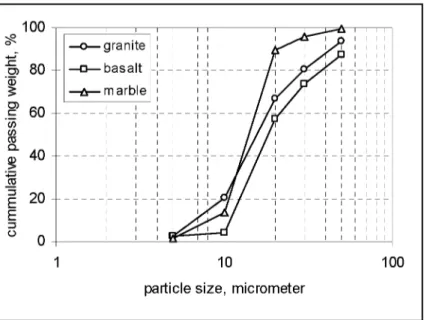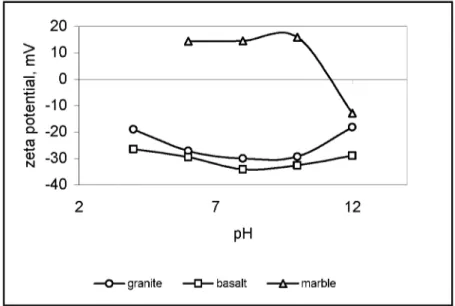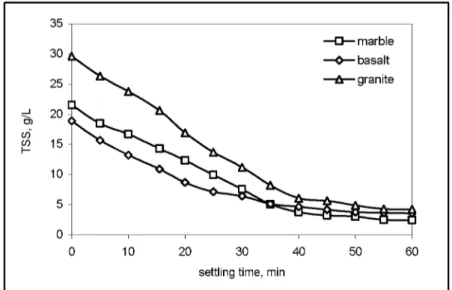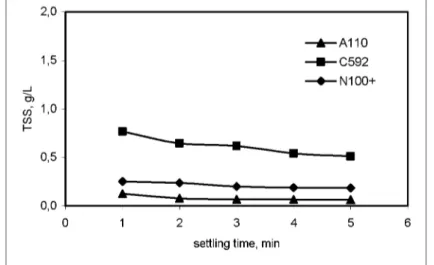©BEYKENT UNIVERSITY
REMOVAL OF SUSPENDED SOLID
MATERIALS FROM THE WASTEWATER OF
NATURAL DIMENSION STONE CUTTING
PLANTS BY FLOCCULATION
Savaş ŞENER
Department of Environmental Engineering, University of Mersin, 33343 Mersin, Turkey, +90-324-361-00-01/7089; e-mail: sasener@mersin.edu.tr
ABSTRACT
During the processing of natural dimension stones (NDS), the wastewater produced is either re-used in the process or discharged into the aquatic environment. The suspended solids must be removed from the effluent prior to re-using or discharging into environment. In order to remove the fine particles, large basins are needed to provide sufficient retention time due to the extreme low settling velocities, therefore, organic polymers (flocculants) have to be added to increase the settling velocity and the efficiency of settling basins. In this study, flocculation characteristics of NDS namely marble, granite and basalt were investigated using three commercial flocculants such as anionic (A-110), cationic (C-592) and non-ionic (N-100 plus). The primary particle properties such as particle size, size distribution as well as their dispersion properties like solid concentration, suspension pH and zeta potential on settling rate and supernatant concentration in solids have also been considered. Results showed that among the three different flocculants tested, anionic flocculant for marble sample; cationic flocculant for granite and basalt samples gave the best result. The flocculant dosage affected significantly the settling rate of the suspension as well as the clarity of the supernatant. The anionic A110, flocculant with 3 mg/L dosage showed the optimum performance for marble suspension while the cationic C592 flocculant with 4 and 3 mg/L dosage found enough for granite and basalt suspensions, respectively.
Keywords: Dimension stone, marble, basalt, granite, removal of suspended solids, flocculation
ÖZET
Doğal yapı malzemelerinin işlenmesi sırasında çıkan atıksu ya proses içerisinde tekrar kullanılmakta ya da sucul ortama deşarj edilmektedir. Deşarj öncesi atıksudaki askıda katı maddeler giderilmelidir. Düşük çökme hızlarından dolayı çok ince boyuttaki katıların çöktürülebilmesi için çok geniş alanlı havuzlara ihtiyaç duyulduğu için çökme hızlarını artırmak için organik polimerler (flokülant) kullanılır.
Bu çalışmada, mermer, granit ve bazalt tanelerinin çöktürülmesinde üç tip (anyonik A-110, katyonik C-592 ve iyonik olmayan N-100 plus) ticari flokülantların çöktürebilme karakteristikleri incelenmiştir. Çalışmalarda tane boyutu ve dağılımı, bunun yanında tanelerin süspansiyon içindeki davranışını belirleyen katı derişimi, pH ve tanelerin zeta potansiyellerinin çökme hızı ve duru fazdaki katı derişimine etkisi incelenmiştir.
Elde edilen sonuçlar denenen üç flokülantın arasında mermer taneleri için anyonik, bazalt ve granit için ise katyonik flokülantlar en iyi sonucu vermiştir. Flokülant dozu tanelerin çökme hızını dolayısıyla atıksuyun duruluğunu belirlemektedir. Mermer tozu içeren atıksuda 3 mg/L dozda anyonik A-110; granit ve bazalt atıksuyunda ise katyonik C592 flokülantının sırasıyla 4 ve 3 mg/L dozları yeterli bulunmuştur.
Anahtar Kelimeler: Doğal yapı malzemeleri, mermer, bazalt, granit, askıda katı madde giderimi, flokülasyon
1. INTRODUCTION
Natural dimension stones (marble, basalt and granite) are cut into slabs or plates with rotating blades and are finished by polishing processes. Water is mainly used as a cooling media in the cutting processes and takes away all the particles produced during cutting and polishing. Suspended solids in the wastewater produced can lead to the development of sludge deposits when untreated wastewater is discharged in the aquatic environment. The wastewater containing fines is pre-treated through sedimentation tanks prior to discharge or is recycled to reuse the treated wastewater instead of fresh water. In order to remove the fine particles, large basins are needed to provide sufficient retention time to settle the slow settling fines completely [1]. Otherwise, the re-circulated water containing high solid concentration when reused reduces the usable life of the cutting blades.
Due to the extreme low settling velocities, organic polymers (flocculants) have to be added to increase the settling velocity and the efficiency of settling
basins. Therefore, flocculation enhances subsequent sedimentation by increasing particle size, resulting in increased settling rate [2].
Flocculation is the physical process of bringing the destabilized very fine particles (e.g., <5^m) with polymolecules (flocculant) in contact to form larger flocs that can be more easily removed from suspension [3]. Flocculants are mostly synthetic polymers based on repeating units of acrylamide and its derivatives, which may contain either cationic or anionic charge. For nonionic polymers such as polyacrylamides, hydrogen bonding and/or hydrophobic forces are believed to be the main driving forces for adsorption. Polymeric flocculants provide enhanced formation of larger aggregates (flocs) of particles by three general mechanisms called charge neutralisation, electrostatic-patching and bridging. Although various flocculation mechanisms are possible, the most important is flocculation by bridging. Bridging is considered to be a consequence of the adsorption of the segments of the flocculant macromolecules onto the surfaces of more than one particle. It is generally believed that low molecular weight polymers tend to adsorb and neutralise the opposite charges on the particles. Consequently, flocculation is caused by the reduction in the electric double layer repulsion between particles. Charge patch attraction occurs when the particle surface is negatively charged and the polymer is positively charged. Bridging is considered to be a consequence of the adsorption of the segments of flocculant macromolecules onto the surfaces of more than one particle [4].
While adsorption of the polymer is necessary for bridging flocculation to occur, it is important to realize that adsorption and flocculation are not separate, sequential processes, but occur simultaneously [5]. Optimum flocculation occurs at flocculant dosages corresponding to a particle coverage that is significantly less than complete. Incomplete surface coverage ensures that there is sufficient unoccupied surface available on each particle for adsorption during collisions of segments of the flocculant chains attached to the particles [6].
There are only a few studies on flocculation of marble wastewater [7-10]. In the studies, zeta potential of the marble particles exhibited negative charge within the all pH employed and both cationic and anionic flocculants were found to flocculate the marble particles at different levels. In the study performed on flocculation of travertine suspension [11], the effects of suspension pH and charge density of anionic polyacrylamide (PAA) on flocculation behavior of two different natural stone suspensions (NSS) marble and travertine were investigated by settling rate and turbidity as indicators. At pH of 11, the settling rate of both natural stones increased significantly with anionic polymer.
In this study, flocculation characteristics of fines of different natural dimension stones namely marble, basalt and granite were investigated using three commercial flocculants such as anionic, cationic and non-ionic. The primary particle properties such as particle size, size distribution as well as their dispersion properties like solid concentration, suspension pH and zeta potential on settling rate and supernatant concentration in solids have also been considered.
2. MATERIALS AND METHOD
In the experiments three different wastewater of natural dimension stones, marble, granite and basalt, were used. The pH and solid ratio of the marble, granite and basalt slurries were 9.1, 8.5 and 7.6, and 21.52%, 29.64% and 18.91% (w/w), respectively. The particle size analysis determined by sub-sieve technique using the Andreasen Pipette.
Anionic Superfloc (A110), non-ionic (N-100 Plus) Superfloc flocculants and cationic Magnafloc (C592), obtained from the American Cyanamid Company and Allied Colloids Inc., respectively, were used for the flocculation experiments.
Electrokinetic studies were performed, to determine zeta potential of the particles in the slurry, in the Rank Brothers Electrophoresis Apparatus. Effect of pH on the sign and values of zeta potential were examined. In the apparatus, platinum electrodes were used and all measurements were conducted at 80V and 298 K. The suspension was ultrasonicated in ultrasonic bath (35 kHz) for 5 min in order to break up aggregates in the suspension prior to measurement. The resultant suspension (100 mL) was conditioned for 10 minutes during which pH was adjusted to predetermined pH by addition of a NaOH or HCl (0.1 N) solution under continuous stirring. A WTW 340i model pH meter was used for measurement of pH of solutions. The zeta potential values were calculated from electrophoretic mobility using the Smoluchowski equation [12].
The flocculation experiments were carried out at room temperature in Velp FC45 model Jar Test apparatus. For each test a 250 mL sample of the suspension was placed into a 500 mL glass beaker. Prior to the flocculation tests 0.1% (weight/volume, w/v) stock solution of the flocculant was prepared with distilled water and diluted to 0.01% (w/v) before use. The dispersed suspension was first conditioned at 500 rpm for 5 minutes and the solution of flocculant was added to the suspension under continuous mixing condition. After 2 minutes of time the stirring speed was reduced to 100 rpm for 2
minutes, to allow floc growth. After various settling time, 20 mL of supernatant was taken out at a fixed distance of 2 cm below the air-liquid interface. In all of the flocculation tests, the effect of various operating parameters, such as pH, type and amount of flocculant, on the performance of flocculation were tested. Concentration of total suspended solid (TSS) in the supernatant was used as an indicator for the flocculation tests.
3. RESULTS AND DISCUSSION
3.1. CHARACTERIZATION OF THE SUSPENSIONS 3.1.1. PARTICLE SIZE ANALYSIS OF THE FINES
Particle size determination by the sub-sieve sizing technique is based on the Stokes law and employs the relationship between time and travel distance of particles and particle settling in a viscous liquid. The particle size distribution of the marble, granite and basalt particles in their suspensions are given in Figure 1. According to the results obtained from the figure, 80% of the total marble, granite and basalt particles (d80) are finer than 40 |im, 30 |im and 19 |im, respectively. 100 -T £ 80 --cu 5: ? 6 0 -w w TO I 4 0 -JO ! 20 --E ° 0--1
3.1.2. ZETA POTENTIAL OF THE SOLIDS
The zeta potentials of marble, granite and basalt l were determined as a function of pH and are given in Figure 2. The electrokinetic measurements could not be done due to the dissolution of marble particles below pH 6. As seen in the figure, an isoelectrical point for marble was obtained at about pH 11 below which zeta potential is positive. The isoelectrical point for neither granite nor basalt was obtained within pH 6-12 where zeta potential values were all negative.
PH
granite —•— basalt —A— marble
Figure 2. Zeta potential of solids as a function of pH.
It is known that the magnitude of zeta potential exerts an important influence on the state of aggregation of the particles in water. When the magnitude of zeta potential is high, the electrostatic repulsion between particles causes the minerals to disperse readily and form stable suspensions. On the other hand, for higher magnitude of zeta potential, the attraction between the particles and oppositely charged polymer surface causes formation of bridging forming agglomerates resulting in faster settling characteristics.
3.2. STABILITY OF SOLID SUSPENSIONS IN THE ABSENCE OF POLYMER
The samples of the suspensions are allowed to settling in the absence of polymer. Total suspended solids (TSS) in the supernatant as a function of settling time in the absence of any polymer are given in Figure 3. As seen in
the figure, without any flocculant addition, settling rate is extremely low and macroscopic observation revealed that the suspended solids were very fine to colloidal and their settling was not possible even after their settling time is increased.
settling time, min
Figure 3. Total suspended solid (TSS) in the supernatant as a function of settling time in the absence of any polymer.
3.3. FLOCCULATION STUDIES
3.3.1. EFFECT OF FLOCCULANT TYPE
Three different flocculants with 6 mg/L addition dosage were tested for three samples of suspensions at inherent pH value separately. The performance of the flocculants was evaluated with respect to concentration of TSS in the supernatant. The results are given in Figures 4-6.
As seen in the figures, anionic flocculant for marble sample; cationic flocculant for granite and basalt samples gave the best result.
Among the three different flocculants tested for the marble suspension, the most effective proved to be the anionic one for probably because of the positive surface charge of the surface of the marble particles. Similarly, the positive charged surface of cationic flocculant for the negatively charged granite and basalt particles were more effective to form bridging. The results are consistent with the results of zeta potential measurements. The polymer bridging mechanism is responsible for flocculation of the suspensions [11].
Coulombic interactions between flocculant chains and surface of the particles play a decisive role on polymer adsorption onto minerals surface.
On the other hand, hydrogen bonding between hydrogen of the polymeric chains and oxygen of the various minerals surface seems to be the driving mechanism of adsorption of the non-ionic flocculant onto particles. In all case, the non-ionic flocculant was found to be considerably effective.
Figure 4. Total suspended solid (TSS) in the supernatant of marble wastewater as a function of settling time (at pH 9.1 and 6 mg/L flocculant addition).
Figure 5. Total suspended solid (TSS) in the supernatant of granite wastewater as a function of settling time (at pH 8.5 and 6 mg/L flocculant addition).
settling time, min
Figure 6. Total suspended solid (TSS) in the supernatant of basalt wastewater as a function of settling time (at pH 7.6 and 6 mg/L flocculant addition).
3.3.2. EFFECT OF FLOCCULANT AMOUNT
The settling curves for marble, granite and basalt suspensions as a function of flocculant dosage were obtained for each polymer and the results are given in Figure 7.
flocculant dose, mg/L
Figure 7. Total suspended solid (TSS) in the supernatant as a function of different flocculant dosage (Flocculants used: anionic A110 for marble, cationic C592 for granite
It is clear that flocculation performance increased with increasing addition dosage. As regards the effect of dosage, it is shown that the increase of polymer addition results in an increasing settling rate, possibly due to coverage of the particles surface with polymer chains and a neutralization of the surface charge. The experimental results revealed that there is an optimum as regards concentration of the polymer added into the particles suspension. The anionic A110 flocculant with 3 mg/L dosage showed the optimum performance for marble suspension, while the cationic C592 flocculant with 4 and 3 mg/L dosage was found to be enough for granite and basalt suspensions, respectively.
4. CONCLUSION
The following results can be inferred from this study:
• An isoelectrical point for marble was obtained at about pH 11 below which zeta potential is positive. The isoelectrical point for neither granite nor basalt was obtained within pH 6-12 where zeta potential values were all negative. • The electrostatic forces (Coulombic interactions) play an important role on polymer-particle attachment and thus on the flocculation.
• The negative charged anionic flocculant adsorbed to the positively charged surface of marble particles; the positive charged cationic flocculant adsorbed to the negatively charged surfaces of granite and basalt particles. The non-ionic flocculant was found to be considerably effective for all samples.
• The increase of polymer addition results in an increasing settling rate. As regards concentration of the polymer, 3 mg/L anionic polymer dosage in marble suspension, 4 and 3 mg/L cationic polymer dosages in granite and basalt suspensions gave the optimum flocculation performance.
REFERENCES
[1] A. Unlu, M.N. Urgup and H. Hasar, Optimal design of sedimentation tanks for effluent of marble works and use of settled solids in concrete. Civil Engineering and Environmental Systems 20 (1), (2003), 49-59.
[2] L. Semerjian and G. M. Ayoub, High-pH-magnesium coagulation-flocculation in wastewater treatment. Advances in Environmental Research 7(2), (2003), 389-403. [3] A. Sworska, J. S. Laskowski and G. Cymerman, Flocculation of the Syncrude fine tailings. Part I. Effect of pH, polymer dosage and Mg2+ and Ca2+ cations. International Journal of Mineral Processing, 60 (2), (2000), 143-152.
[4] A. Özkan, Coagulation and flocculation characteristics of talc by different flocculants in the presence of cations. Minerals Engineering, 16, (2003), 59-61.
[5] R. Hogg, Polymer adsorption and flocculation. In: Laskowski, J.S., Editor, Polymers in Mineral Processing -Proc. 3rd UBC-McGill Int. Symp., Metallurgical
[6] R. Hogg, Collision efficiency factors for polymer flocculation. J. Coll. Int. Sci. 102, (1984), 232-236.
[7] I. Bayraktar, M. Oner, N. Karapinar and S. Saklar, Wastewater treatment in marble industry In: M. Kemal, V. Arslan, A. Akar and M. Canbazoglu, Editors, Changing Scopes in Mineral Processing, Balkema, Rotterdam (1996), pp. 673-677.
[8] A. Seyrankaya, U. Malayoglu and A. Akar, Flocculation conditions of marble from industrial wastewater and environmental consideration In: G. Ozbayoglu, Editor, Mineral Processing on the Verge of the 21st Century, Balkema, Rotterdam (2000), pp.
645-652.
[9] I. Nishkov and M. Marinov, Calcium carbonate microproducts from marble treatment waste In: L. Kuzev, I. Nishkov, A. Boteva and D. Mochev, Editors, Mineral Processing in the 21st Century, Djiev Trade, Sofia (2003), pp.700-705.
[10] E.I.Arslan, S. Aslan, U. Ipek, S. Altun S and S. Yazicioglu, Physico-chemical treatment of marble processing wastewater and the recycling of its sludge. Waste Management and Research 23 (6), (2005), 550-559.
[11] B. Ersoy, Effect of pH and polymer charge density on settling rate and turbidity of natural stone suspensions. International Journal of Mineral Processing 75 (3-4), (2005), 207-216.
[12] A.L. Smith, Electrical phenomena associated with the solid-liquid interface. Dispersion of Powders in Liquids In: Parfitt, Editor, 2nd Edition, With Special Reference to Pigments, Applied Science Publisher, London (1973), pp.86-131.




